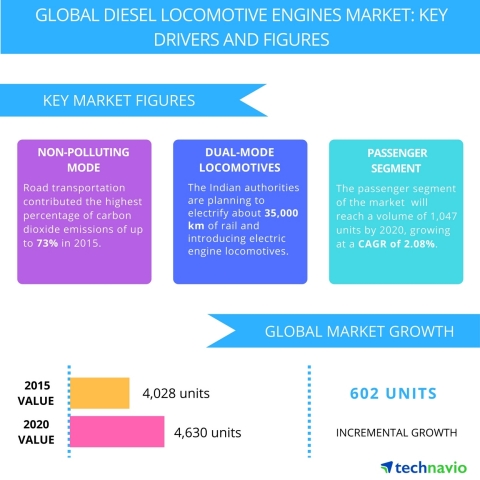Technavio’s latest market research report on the global diesel locomotive engines market provides an analysis of the most important trends expected to impact the market outlook from 2016-2020. Technavio defines an emerging trend as a factor that has the potential to significantly impact the market and contribute to its growth or decline.
This Smart News Release features multimedia. View the full release here: http://www.businesswire.com/news/home/20170102005045/en/

Technavio has published a new report on the global diesel locomotive engines market from 2016-2020.
According to Praveen Kumar, a lead analyst from Technavio, specializing in research on powertrain sector, “Freight transport by rail contributes far lesser emissions as compared to road transport. Growing preference for fuel-efficient and on-time transport of freight are driving the market for diesel locomotive engines in terms of freight transportation.”
Request a sample report:http://www.technavio.com/request-a-sample?report=55408
Technavio’s sample reports are free of charge and contain multiple sections of the report including the market size and forecast, drivers, challenges, trends, and more.
The top three emerging market trends driving the global diesel locomotive engines market according to Technavio automotive research analysts are:
- Hydrogen-powered locomotive engines
- Dual-mode locomotives
- Autonomous locomotive engines for long-distance transport
Hydrogen-powered locomotive engines
Alstom, a locomotive engine manufacturer, launched Coradia iLint, a hydrogen cell powered passenger train in Germany in 2016. This train does not require overhead electric cables for power and is non-polluting to the environment. The train is fueled by hydrogen fuel, which is placed on the roof and produces electric energy by mixing hydrogen and oxygen to generate electricity. This system emits only condensed water and steam as by-products. Since these trains run independently on hydrogen fuel, they do not need expensive infrastructural changes in which lengthy kilometers of rail need to be electrified.
The train can reach speeds up to 90 mph and has an approximate range of 500 miles before refueling. The train has the capacity of ferrying about 300 passengers with seating facilities for 150 people. The train is scheduled to be commissioned by 2017 when it will undertake service on Buxtehude-Cuxhaven route in Germany carrying passengers. Saxony transportation authority has ordered about 14 hydrogen fuel trains to be delivered by the end of 2017.
Dual-mode locomotives
Diesel locomotives in India consume fuel worth USD 3 billion in a year to power the diesel locomotives of the country. Therefore, to reduce this expenditure and increase efficiency, railway authorities in India are exploring the option of developing a hybrid dual-mode engine train that can run on diesel through places, which are not economical to be electrified. The same engine is also able to make use of overhead electric cable for running independently using electric power through places that have electrified rails. The dual-mode train would further alleviate the need for fully replacing a diesel train by adding additional equipment to change to an electric engine locomotive for reducing dependence on petroleum fuels.
Autonomous locomotive engines for long-distance transport
Many autonomous locomotives travel underground for transporting people. Most of these locomotives are automated and can undertake short-distance travel within metros and cities. A centralized controller with control over all the trains and a predefined railroad infrastructure are the main components enabling the intelligent movement of the autonomous locomotive engines within the metros and cities.
Long distance autonomous transport requires a different technology for functioning as the sensors and self-driving algorithms like those used by self-driving cars need to be embedded within the locomotives. Upgrading of a large network of rails with sensors and intelligence algorithms will be too costly, time-consuming, and unreliable, so these are already equipped in locomotives.
“Autonomous locomotives increase the network capacity by enabling trains to be operated with higher frequencies over specified distances. Autonomous trains will have the capability of transporting more amounts of freight economically at a faster pace compared to road transport,” says Praveen.
Browse Related Reports:
- Global Diesel Engine Market 2016-2020
- Global Battery Market for Railways 2016-2020
- Global Intelligent All-Wheel Drive System Market 2016-2020
Become a Technavio Insights member and access all three of these reports for a fraction of their original cost. As a Technavio Insights member, you will have immediate access to new reports as they’re published in addition to all 6,000+ existing reports covering segments like automotive electronics, automotive manufacturing, andautomotive services. This subscription nets you thousands in savings, while staying connected to Technavio’s constant transforming research library, helping you make informed business decisions more efficiently.
About Technavio
Technavio is a leading global technology research and advisory company. The company develops over 2000 pieces of research every year, covering more than 500 technologies across 80 countries. Technavio has about 300 analysts globally who specialize in customized consulting and business research assignments across the latest leading edge technologies.
Technavio analysts employ primary as well as secondary research techniques to ascertain the size and vendor landscape in a range of markets. Analysts obtain information using a combination of bottom-up and top-down approaches, besides using in-house market modeling tools and proprietary databases. They corroborate this data with the data obtained from various market participants and stakeholders across the value chain, including vendors, service providers, distributors, re-sellers, and end-users.
If you are interested in more information, please contact our media team at media@technavio.com.
View source version on businesswire.com: http://www.businesswire.com/news/home/20170102005045/en/






















